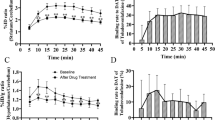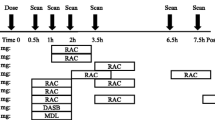Abstract
Rationale
The serotonin 5-HT1B receptor is a potential target for the pharmacologic treatment of depression. Positron emission tomography (PET) determination of 5-HT1B receptor occupancy with drug candidates targeting this receptor in non-human primate and human subjects may facilitate translation of research from animal models and guide dose selection for clinical studies. AZD3783 is a recently developed, orally bioavailable 5-HT1B receptor antagonist with potential antidepressant properties.
Objectives
To determine the relationship between plasma concentration of AZD3783 and occupancy at primate brain 5-HT1B receptors using PET and the radioligand [11C]AZ10419369.
Methods
PET studies with [11C]AZ10419369 were performed in three non-human primates at baseline and after intravenous injection of AZD3783. Subsequently, PET measurements were undertaken in six human subjects at baseline and after administration of different single oral doses of AZD3783 (1–40 mg).
Results
After administration in non-human primates and human subjects, AZD3783 reduced regional [11C]AZ10419369 binding in a dose-dependent and saturable manner. The AZD3783 plasma concentration required for 50% receptor occupancy (K i,plasma) for monkeys was 25 and 27 nmol/L in occipital cortex and striatum, respectively. Corresponding estimates for human occipital cortex and ventral striatum were 24 and 18 nmol/L, respectively.
Conclusions
The potential antidepressant AZD3783 binds in a saturable manner to brain 5-HT1B receptors with a similar in vivo affinity for human and monkey receptors. [11C]AZ10419369 can be successfully used to determine occupancy at brain 5-HT1B receptors in vivo and constitutes a useful tool for dose selection in clinical studies with 5-HT1B receptor compounds.








Similar content being viewed by others
References
Bergström M, Boethius J, Eriksson L, Greitz T, Ribbe T, Widén L (1981) Head fixation device for reproducible position alignment in transmission CT and positron emission tomography. J Comput Assist Tomogr 5:136–141
Black K, Shea C, Dursun S, Kutcher S (2000) Selective serotonin reuptake inhibitor discontinuation syndrome: proposed diagnostic criteria. J Psychiatry Neurosci 25:255–261
Blier P, de Montigny C (1994) Current advances and trends in the treatment of depression. Trends Pharmacol Sci 15:220–226
Bonaventure P, Voorn P, Luyten WH, Jurzak M, Schotte A, Leysen JE (1998) Detailed mapping of serotonin 5-HT1B and 5-HT1D receptor messenger RNA and ligand binding sites in guinea-pig brain and trigeminal ganglion: clues for function. Neuroscience 82:469–484
Bruinvels AT, Lery H, Nozulak J, Palacios JM, Hoyer D (1992) 5-HT1D binding sites in various species: similar pharmacological profile in dog, monkey, calf, guinea-pig and human brain membranes. Naunyn Schmiedebergs Arch Pharmacol 346:243–248
Dawson LA, Hughes ZA, Starr KR, Storey JD, Bettelini L, Bacchi F, Arban R, Poffe A, Melotto S, Hagan JJ, Price GW (2006) Characterisation of the selective 5-HT1B receptor antagonist SB-616234-A (1-[6-(cis-3, 5-dimethylpiperazin-1-yl)-2, 3-dihydro-5-methoxyindol-1-yl]-1-[2′-methyl-4′-(5-methyl-1, 2, 4-oxadiazol-3-yl)biphenyl-4-yl]methanone hydrochloride): in vivo neurochemical and behavioural evidence of anxiolytic/antidepressant activity. Neuropharmacology 50:975–983
Engel G, Göthert M, Hoyer D, Schlicker E, Hillenbrand K (1986) Identity of inhibitory presynaptic 5-hydroxytryptamine (5-HT) autoreceptors in the rat brain cortex with 5-HT1B binding sites. Naunyn Schmiedebergs Arch Pharmacol 332:1–7
Eriksson L, Holte S, Bohm C, Kesselberg M, Hovander B (1988) Automated blood sampling systems for positron emission tomography. IEEE Trans Nucl Sci 35:703–707
Farde L, Eriksson L, Blomquist G, Halldin C (1989) Kinetic analysis of central [11C]raclopride binding to D2-dopamine receptors studied by PET—a comparison to the equilibrium analysis. J Cereb Blood Flow Metab 9:696–708
Finnema SJ, Varrone A, Hwang TJ, Gulyás B, Pierson ME, Halldin C, Farde L (2010) Fenfluramine-induced serotonin release decreases [11C]AZ10419369 binding to 5-HT1B-receptors in the primate brain. Synapse 64:573–577
Halldin C, Swahn CG, Farde L, Sedvall G (1995) Radioligand disposition and metabolism. In: Comar D (ed) PET for drug development and evaluation. Kluwer, Dordrecht, pp 55–65
Hudzik T, Smolka J, Litwin L, Porrey T, Pierson ME (2003a) In vivo pharmacology of AZD1134, a novel 5-HT1B antagonist. Eur Neuropsychopharmacol 13:S181–S182
Hudzik TJ, Yanek M, Porrey T, Evenden J, Paronis C, Mastrangelo M, Ryan C, Ross S, Stenfors C (2003b) Behavioral pharmacology of AR-A000002, a novel, selective 5-hydroxytryptamine1B antagonist. J Pharmacol Exp Ther 304:1072–1084
Karlsson P, Farde L, Halldin C, Swahn CG, Sedvall G, Foged C, Hansen KT, Skrumsager B (1993) PET examination of [11C]NNC 687 and [11C]NNC 756 as new radioligands for the D1-dopamine receptor. Psychopharmacology (Berl) 113:149–156
Karlsson P, Farde L, Halldin C, Sedvall G, Ynddal L, Sloth-Nielsen M (1995) Oral administration of NNC 756—a placebo controlled PET study of D1-dopamine receptor occupancy and pharmacodynamics in man. Psychopharmacology (Berl) 119:1–8
Lammertsma AA, Hume SP (1996) Simplified reference tissue model for PET receptor studies. Neuroimage 4:153–158
Logan J, Fowler JS, Volkow ND, Wolf AP, Dewey SL, Schlyer DJ, MacGregor RR, Hitzemann R, Bendriem B, Gatley SJ, Christman DR (1990) Graphical analysis of reversible radioligand binding from time–activity measurements applied to [N-11C-methyl]-(−)-cocaine PET studies in human subjects. J Cereb Blood Flow Metab 10:740–747
Maier DL, Powell ME, Ding M, Hill G, Tuke D, Heys R, Elmore CS, Mrzljak L, Pierson ME (2008) Receptor occupancy of AZ12320927, a serotonin 5-HT1B receptor antagonist, using [N-methyl-3H3]AZ10419369 in the guinea pig brain. Soc Neurosci Abstr, pp 558.554
Maier DL, Sobotka-Briner C, Ding M, Powell ME, Jiang Q, Hill G, Heys JR, Elmore CS, Pierson ME, Mrzljak L (2009) [N-methyl-3H3]AZ10419369 binding to the 5-HT1B receptor: in vitro characterization and in vivo receptor occupancy. J Pharmacol Exp Ther 330:342–351
Maura G, Raiteri M (1986) Cholinergic terminals in rat hippocampus possess 5-HT1B receptors mediating inhibition of acetylcholine release. Eur J Pharmacol 129:333–337
Mawlawi O, Martinez D, Slifstein M, Broft A, Chatterjee R, Hwang DR, Huang Y, Simpson N, Ngo K, Van Heertum R, Laruelle M (2001) Imaging human mesolimbic dopamine transmission with positron emission tomography: I. Accuracy and precision of D2 receptor parameter measurements in ventral striatum. J Cereb Blood Flow Metab 21:1034–1057
Moret C, Briley M (2000) The possible role of 5-HT1B/D receptors in psychiatric disorders and their potential as a target for therapy. Eur J Pharmacol 404:1–12
Murrough JW, Henry S, Hu J, Gallezot JD, Planeta-Wilson B, Neumaier JF, Neumeister A (2010) Reduced ventral striatal/ventral pallidal serotonin1B receptor binding potential in major depressive disorder. Psychopharmacology. doi:10.1007/s00213-010-1881-0
Oksenberg D, Marsters SA, O'Dowd BF, Jin H, Havlik S, Peroutka SJ, Ashkenazi A (1992) A single amino-acid difference confers major pharmacological variation between human and rodent 5-HT1B receptors. Nature 360:161–163
Pierson ME, Andersson J, Nyberg S, McCarthy DJ, Finnema SJ, Varnäs K, Takano A, Karlsson P, Gulyás B, Medd AM, Lee CM, Powell ME, Heys JR, Potts W, Seneca N, Mrzljak L, Farde L, Halldin C (2008) [11C]AZ10419369: a selective 5-HT1B receptor radioligand suitable for positron emission tomography (PET). Characterization in the primate brain. Neuroimage 41:1075–1085
Roland PE, Graufelds CJ, Wåhlin L, Ingelman L, Andersson M, Ledberg A, Pedersen J, Åkerman S, Dabringhaus A, Zilles K (1994) Human brain atlas: for high-resolution functional and anatomical mapping. Hum Brain Mapp 1:173–184
Ruf BM, Bhagwagar Z (2009) The 5-HT1B receptor: a novel target for the pathophysiology of depression. Curr Drug Targets 10:1118–1138
Stenfors C, Hallerback T, Larsson LG, Wallsten C, Ross SB (2004) Pharmacology of a novel selective 5-hydroxytryptamine1B receptor antagonist, AR-A000002. Naunyn Schmiedebergs Arch Pharmacol 369:330–337
Svenningsson P, Chergui K, Rachleff I, Flajolet M, Zhang X, El Yacoubi M, Vaugeois JM, Nomikos GG, Greengard P (2006) Alterations in 5-HT1B receptor function by p11 in depression-like states. Science 311:77–80
Udo de Haes JI, Harada N, Elsinga PH, Maguire RP, Tsukada H (2006) Effect of fenfluramine-induced increases in serotonin release on [18F]MPPF binding: a continuous infusion PET study in conscious monkeys. Synapse 59:18–26
Varnäs K, Hall H, Bonaventure P, Sedvall G (2001) Autoradiographic mapping of 5-HT1B and 5-HT1D receptors in the post mortem human brain using [3H]GR 125743. Brain Res 915:47–57
Varnäs K, Nyberg S, Halldin C, Varrone A, Takano A, Karlsson P, Andersson J, McCarthy D, Smith M, Pierson ME, Söderström J, Farde L (2010) Quantitative analysis of [11C]AZ10419369 binding to 5-HT1B receptors in human brain. J Cereb Blood Flow Metab. doi:10.1038/jcbfm.2010.55
Wienhard K, Dahlbom M, Eriksson L, Michel C, Bruckbauer T, Pietrzyk U, Heiss WD (1994) The ECAT EXACT HR: performance of a new high resolution positron scanner. J Comput Assist Tomogr 18:110–118
Wilson SJ, Bailey JE, Nutt DJ (2005) Dizziness produced by a potent 5HT1A receptor agonist (eptapirone) is not due to postural hypotension. Psychopharmacology (Berl) 179:895–896
Zhang M, Zhou D, Wang Y, Maier DL, Widzowski DW, Sobotka-Briner CD, Brockel BJ, Potts WM, Pierson ME (2011) Preclinical pharmacology and pharmacokinetics of AZD3783, a selective 5-HT1B receptor antagonist. J Pharmacol Exp Ther, submitted
Acknowledgments
The authors thank all members of the PET group at the Karolinska Institutet, Christina M. Resuello, and the Bioanalytical section of Drug Metabolism and Pharmacokinetics, AstraZeneca R&D, Wilmington, DE for the excellent technical assistance during this study. The work at Karolinska Institutet was supported by a grant from AstraZeneca and the Swedish Science Council (VR 09114).
Author information
Authors and Affiliations
Corresponding author
Rights and permissions
About this article
Cite this article
Varnäs, K., Nyberg, S., Karlsson, P. et al. Dose-dependent binding of AZD3783 to brain 5-HT1B receptors in non-human primates and human subjects: a positron emission tomography study with [11C]AZ10419369. Psychopharmacology 213, 533–545 (2011). https://doi.org/10.1007/s00213-011-2165-z
Received:
Accepted:
Published:
Issue Date:
DOI: https://doi.org/10.1007/s00213-011-2165-z




